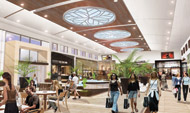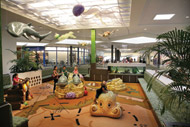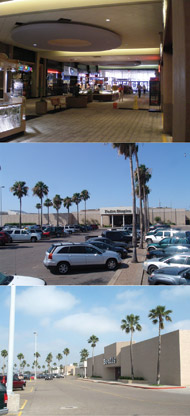| FEATURE ARTICLE, MAY 2010
LA PALMERA LEEDs THE WAY IN SUSTAINABLE DEVELOPMENT
Trademark’s transformation of the former Padre Staples Mall in Corpus Christi is the first LEED-certified enclosed mall.
By Randall Shearin
 |
A rendering of the Transformed Padre Staples Mall, now known as La Palmera.
|
|
Padre Staples Mall in Corpus Christi had always been the top center in the area — mainly because it was the only regional mall in the market. Independently owned and heavily marketed for most of its history, the mall had only had a few facelifts over the years. In 2008, Fort Worth-based Trademark Properties became interested in the center. The demographics and barriers to entry of the center, as well as its prime location along South Padre Island Drive, were key attractions. As the firm did its due diligence on the property, Trademark began to realize the potential for Padre Staples Mall if it were renovated and revitalized.
“This is the market-dominant property for the whole Coastal Bend region,” says Terry Montesi, chairman and CEO of Trademark Properties. “There is no competition. While the center hadn’t been brought into the 21st Century, it was still highly productive. We also knew that if we could capture the tourists and could attract some of the Mexican shoppers who cross the border to buy goods, the sky could be the limit.”
While it was considering acquiring the center, Trademark heard that another developer was contemplating building a center in the market about 4 miles from Padre Staples Mall. That developer had already secured agreements with several anchors to move to its center. This was despite the fact that Padre Staples Mall was performing at sales of around $500 per square foot.
“Our reaction was, of course, that it was the wrong thing to do,” Montesi says. “We knew there was only room for one mall to be successful in Corpus Christi. Padre Staples was the prime main and main location. It was wrong for the city and wrong for the retailers to move.”
After discussions with the retailers, Trademark proceeded with its acquisition plans of the center. It then worked a deal with the city for a public-private partnership to redevelop the center. In the end, the anchors ended up staying at Padre Staples, and the other project became a victim of the slowdown in the economy. Despite the economic times, once it had acquired the center, Trademark stayed true to its words and set about a major renovation that transformed Padre Staples Mall into La Palmera.
Trademark de-malled the main entrance to the center and added lifestyle amenities with new retailers and restaurants. Palm trees line the center, while a pop jet fountain stretches along the entrance walk. Working with Boulder, Colorado-based CommArts, Trademark designed the center to appeal to all walks of life.
“We took this from a dark center to a very bright, lively center, adding outdoor space and space that brings the outdoors in,” Montesi says. “We now have a place where people can dine al fresco, and kids can play in the pop fountain.”
 |
The new Undersea Adventure play area.
|
|
Directly behind the main entrance is La Palmera’s center court, which was completely redone. Clerestory windows and a tall glass entry way opened the area up to the outdoors and brought in plenty of natural light. A new fountain was also installed. La Palmera is the first enclosed mall renovation to be LEED-Silver certified. Trademark accomplished this goal by keeping the certification in mind from the start. LEED certification is an area where Trademark has broken ground before. The company’s Watters Creek at Montgomery Farm in Allen is the first large mixed-use development in the Texas to be LEED certified.
“LEED certification is one of our guiding principles,” Montesi says. “We wanted to have a sustainable environment, and we wanted to meet the market. The citizens of Corpus Christi are very in tune with their natural resources. It is a green area.”
La Palmera’s resort-style feel comes from the fact that Trademark wanted to create a retail destination for the area. Corpus Christi has more than 7 million tourists visit each year, and the old center was doing nothing to capture that market or the cross-border shoppers.
“Our whole design intent, knowing that we would have a large tourism draw and we are near the beach, was to have a resort feel,” Montesi says. “We wanted the center to capture the feeling that people have when they are on vacation or if they are living the lifestyle of this area full-time.”
 |
The facade and interior of La Palemera before Trademark broke ground on extensive renovations.
|
|
A big part of the center’s transformation was Trademark’s leasing strategy. Even with the center’s strong sales, it hadn’t attracted a lot of the better national tenants. “There were no restaurants as part of the mall, no lifestyle retailers and really no amenities,” Montesi says. “It was a conventional, 40-year-old shopping place.”
Since it began the renovation, La Palmera has been able to attract a number of new tenants. One of the first to sign was P.F. Chang’s China Bistro, one of only a few deals the restaurant did in 2009. Grimaldi’s Pizza, who has been successful in several of Trademark’s other centers, also signed on early. The center is anchored by Macy’s, JC Penney, Dillard and Beall’s. As the center was renovated, Macy’s expanded its location by 19,000 square feet, while Dillard’s and JC Penney remodeled their stores and upgraded their offerings at the center. Trademark asked several tenants to relocate within the mall and had a number of tenants sign renewals who installed their new store formats at La Palmera. Zale, Spencer Gifts, Lane Bryant and The Buckle were among the retailers who went that route. Claire’s moved to an upstairs location and saw its business improve. Charming Charlie, Van’s and Ulta are among the other new leases that Trademark has signed to La Palmera.
“We were very successful in getting tenants who were there to upgrade and invest in their newer prototypes,” says Montesi. “We were also successful in getting a number of tenants to move. We had no one leave who we wanted to stay.”
Complicating the renovation was the fact that the previous owner was about 60 percent completed with a $13 million renovation. Trademark stopped that work, altered some of the plans, removed others altogether and added its own ideas. In some cases, Trademark razed work that had been completed already to have more successful results. Work was well along in the food court area, where Trademark halted progress to put in a two-story atrium with skylights and added escalators. In all, Montesi estimates that Trademark spent about $50 million on the renovation. The 36,000-square-foot La Palmera Cafes food court has a 4,400-gallon aquarium that serves as a visual element to demarcate the area. It catches shoppers’ attention and has become a real landmark — or perhaps Trademark — of the center. Seating 600, the food court itself has all new tenants, such as Chick-fil-A, Villa Fresh Italian Kitchen, Sarku Japan, Subway, Stir Fry 88 and Wendy’s.
Trademark added a children’s play area on the second floor with an Undersea Adventure theme that has been a huge hit. Treasure map carpeting and soft marine-like structures for children to climb on complement the theme.
La Palmera has begun running commercials on Mexican television to attract shoppers, and the center is also running billboards and other marketing campaigns in the tourist district near the center.
“We are really tourist-worthy now,” Montesi says. “Before, when it was a conventional mall, there wouldn’t have been any reason for an out-of-town tourist to visit.”
Trademark continues to work on leasing and marketing efforts as it finalizes the renovation. A grand opening for the center is planned for early summer.
©2010 France Publications, Inc. Duplication
or reproduction of this article not permitted without authorization
from France Publications, Inc. For information on reprints of
this article contact Barbara
Sherer at (630) 554-6054.
|
